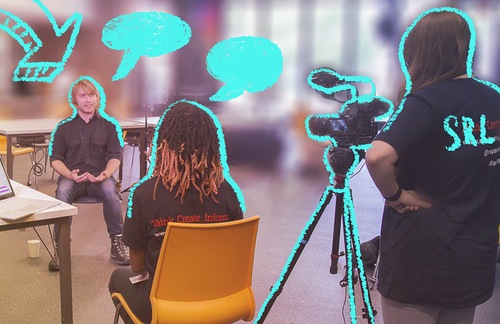
Preparation and practice are the keys to a successful interview and amazing story. This lesson uses a famous art project, Humans of New York, to reverse-engineer good interview questions and techniques. Before you write your own interview questions, understand your goal: to get soundbites that connect with your audience, illuminate the topic and move your story forward. Click on the Activities Tab to complete the lesson.
This lesson can be used at any time to build communication, problem-solving, and organization skills. Use this lesson as a stand-alone, or the warm-up to the interview preparation lesson as part of your student journalism project.
Interviews are central to most stories you see in the news. By doing an interview, students will have a much deeper understanding of the process, challenges, and decisions made by reporters and editors. These are all critical parts of media literacy and understanding the different elements of journalism that result in the video, audio, or text story that you find online.
Practicing interviews will help students understand how people talk with one another and explore different perspectives. Additionally, students who go outside their school walls and conduct interviews with local leaders, experts, etc. are engaging with their community in powerful and meaningful ways. Interviews help students follow their curiosity, go beyond textbooks and google, and gives them a tool to explore topics in real-world situations.
Interviewing requires you to actively listen, focus, think on your feet, and react appropriately to what the other person says. When you plan for an interview, you need to assess what you don’t know—a metacognitive skill—and learn a lot about the interview subject because otherwise, the interview will be awkward. This is real life, with real consequences if you’re unprepared and a real payoff if you do well—the heart of project-based learning.
Listening and really trying to appreciate where the other person is coming from is also an exercise in empathy and discovering how to connect. These life skills will help prepare students for college and jobs, and interviewing is a great way to address high school ELA and NGSS standards around communication, evaluating pertinent information, pulling important quotes, and emphasizing salient points, as well as ISTE and media literacy standards of digital production and multimedia presentations.
A really fun and engaging way to practice composing better questions is to reverse engineer Humans of New York, a project that started when photographer Brandon Stanton decided to tell the stories of 10,000 random people. Stanton meets people on the street, takes their picture, and interviews them. He publishes each picture with a snippet of the interview in which the person describes something significant from their life.
This lesson is based on an exercise that Iowa English teacher Sarah Brown Wessling created to help her students get to know each other.
Estimated time to complete: 20 Minutes
Explain that today’s lesson is about how to write good interview questions.
You will use Humans of New York to reverse-engineer effective interview questions.
Show the following slides one at a time.
View this video interview with Brandon Stanton, in which he recounts the background of “Humans of New York,” his motivation for pursuing it, and its growth into a global project.
After viewing, have students individually complete a “Connect-Extend-Challenge” reflection:
Consider what you have just read, seen, or heard, and then ask yourself:
Then, as a whole group, discuss:
Divide the class into groups of three for practice interviews. Explain that they are going to practice interviewing each other. Choose a goal for the interview:
Explain that reporters avoid yes or no questions.
Each student will interview another student for 4 minutes and then the third person in the group will give them feedback on their questions and their interviewing technique. Keep Slide 11 up at the front of the room. (Student A interviews B, and Student C gives feedback; Student B interviews C and Student A gives feedback; Student C interviews Student A and Student B gives feedback)
Students should use this feedback template (Slide 11):
At the end of the class, ask the reflection questions below.
Ask: What did you learn from working on this project? What did you like best about it? What did you dislike and why?
Ask: How might interviewing skills be useful in your life right now? In the future?
This resource is part of the Global Education Toolkit and was made possible with support from the Longview Foundation.
A conversation between two or more people where the purpose is to gather information and facts. The interviewer asks questions and the interviewee provides information based on their knowledge about a specific topic or issue.
The term “empathy” is used to describe a wide range of experiences. A generally definition is the ability to sense other people’s emotions, coupled with the ability to imagine what someone else might be thinking or feeling. In media-making, creators can have empathy for their subjects and the audience can empathize with the characters.
A short extract or clip from a recorded interview, chosen for its relevance to the story, pungency or appropriateness.
Students recognize the responsibilities and opportunities for positively contributing to their digital communities. (ISTE)
Students leverage technology to take an active role in choosing, achieving and demonstrating competency in their learning goals, informed by the learning sciences. (ISTE)
Students communicate clearly and express themselves creatively for a variety of purposes using the platforms, tools, styles, formats and digital media appropriate to their goals. (ISTE)
Journalism
Civics
Media Literacy
Lessons
Beginner
Intermediate
Slides
Notebook
50 Minutes